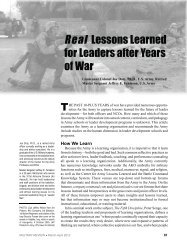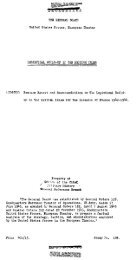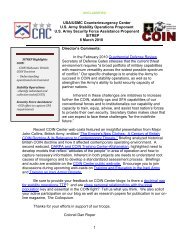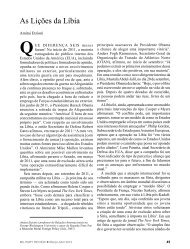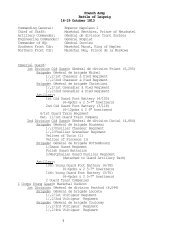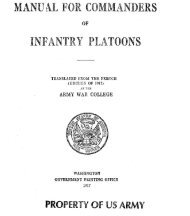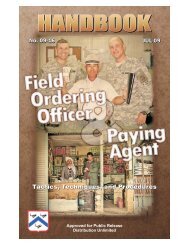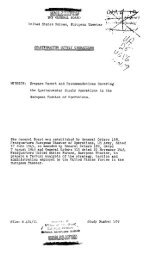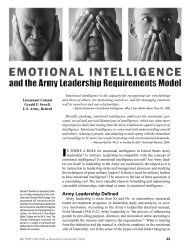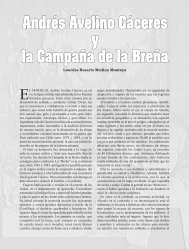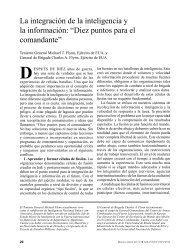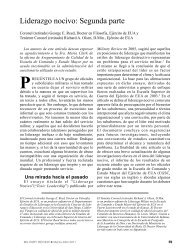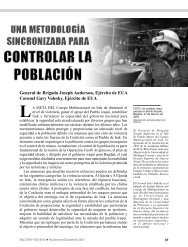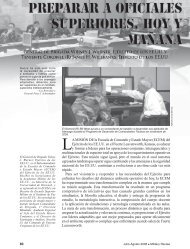military - US Army Combined Arms Center and Fort Leavenworth
military - US Army Combined Arms Center and Fort Leavenworth
military - US Army Combined Arms Center and Fort Leavenworth
You also want an ePaper? Increase the reach of your titles
YUMPU automatically turns print PDFs into web optimized ePapers that Google loves.
A Model for Comparison<br />
Establishing an educational institution to develop<br />
partner capacity is not a far-fetched concept. Today<br />
men <strong>and</strong> women from the NATO Training Mission-<br />
Afghanistan continue to develop a robust education<br />
system, from entry to retirement, for the Afghan<br />
National Security Forces (ANSF). This institution,<br />
the Afghan National Security University (ANSU), is<br />
a contemporary example of how international forces<br />
support non-Western partners in <strong>military</strong> education. It<br />
incorporates many disparate pieces of <strong>military</strong> education,<br />
from the Afghan Sergeants Major Academy to<br />
a Comm<strong>and</strong> <strong>and</strong> Staff College, <strong>and</strong> from a Foreign<br />
Language Institute to the National Military Academy<br />
of Afghanistan (NMAA).<br />
Each year NMAA graduates approximately 600<br />
new lieutenants for the Afghan National <strong>Army</strong> (ANA)<br />
<strong>and</strong> the Afghan Air Force. Most of these new officers<br />
take positions in the field comm<strong>and</strong>ing troops. Each<br />
year a lottery fills ANA requirements around the country<br />
to prevent political influence on the process <strong>and</strong><br />
enable Afghanistan’s most capable young officers to<br />
fill the most needed positions.<br />
The National Military Academy of Afghanistan is<br />
also an example of local leaders taking responsibility<br />
<strong>and</strong> control of their educational institutions. While the<br />
Afghan <strong>military</strong> leadership runs most of the ANSU<br />
(<strong>and</strong> will run future expansions), NMAA is the best<br />
example of an institution developed by Western forces<br />
<strong>and</strong> transitioned to local control. Today the Afghan<br />
Ministry of Defense <strong>and</strong> the ANA plan <strong>and</strong> execute all<br />
aspects of NMAA, <strong>and</strong> ANSU, <strong>and</strong> the NMAA comm<strong>and</strong>ers<br />
manage, develop, <strong>and</strong> approve the program of<br />
instruction <strong>and</strong> strategic direction. Afghan instructors<br />
are the lead for all the courses, which focus on basic<br />
education like math, science, <strong>and</strong> literacy; <strong>military</strong><br />
leadership <strong>and</strong> character; <strong>military</strong> principles; <strong>and</strong> physical<br />
development. Like the EASC’s proposed curriculum,<br />
these courses increase soldier professionalism <strong>and</strong><br />
provide the necessary skills to lead troops. While this<br />
institution only produces about 600 Afghan officers per<br />
year, its development of a higher caliber officer corps<br />
has shown its value to the ANSF accession system.<br />
One area of concern that must be examined is the<br />
role of coalition militaries partnering with foreign<br />
militaries. The lessons of Iraq <strong>and</strong> Afghanistan clearly<br />
show there is a danger in partnering with developing<br />
foreign militaries. The close proximity affords<br />
insurgents the opportunity to target coalition soldiers<br />
who are training host nations soldiers to become more<br />
professional. For example, the Long War Journal<br />
reports that as of 29 August 2012, there have been 29<br />
green-on-blue attacks for the year that have resulted<br />
in 45 coalition casualties. These 45 casualties account<br />
for 14 percent of total coalition casualty figures. It is<br />
difficult to ascertain the causes for these attacks, but<br />
the journal notes cultural differences played a role. It is<br />
also likely that there were mistakes made in vetting the<br />
individuals who committed the attacks. This is highly<br />
possible considering the rapid expansion of the Afghan<br />
<strong>military</strong> over the last few years. 24<br />
To help combat this disturbing trend, over 300<br />
counterintelligence specialists have been appointed<br />
by the Afghan <strong>Army</strong> to root out potential saboteurs<br />
<strong>and</strong> assassins. The chief of the Afghan <strong>Army</strong> has also<br />
ordered that 150,000 Afghan soldiers, approximately<br />
three quarters of the army, be revetted <strong>and</strong> enrolled in<br />
a biometrics database. Hundreds of Afghan soldiers<br />
have received discharges due to this increased security<br />
posture. 25<br />
Conclusion<br />
Regardless of whether the United States <strong>Army</strong> is<br />
ready for R2P, it is clear our forces will be required to<br />
undertake operations in support of R2P in the future.<br />
As the 2010 National Security Strategy <strong>and</strong> CSA’s<br />
“Marching Orders” state, our best option is to prevent<br />
mass atrocities that lead to R2P operations through<br />
<strong>military</strong>-<strong>military</strong> engagement. This has happened in<br />
the recent past, when the Egyptian forces refused to<br />
murder their people during the revolutions in early<br />
2011. 26 Decades of developing a relationship between<br />
Egypt <strong>and</strong> the United States through peer-to-peer training<br />
<strong>and</strong> education, as well as <strong>military</strong> funding, played<br />
a role in preventing a massacre .<br />
Any efforts to support professionalization in the<br />
officer corps of African militaries, as well as their<br />
capabilities to prevent mass atrocities, will take years<br />
to pay off. An educational institution like the EASC<br />
for mid-grade officers will require significant planning<br />
<strong>and</strong> “buy-in” by the African Union, the African nations<br />
of EASF, <strong>and</strong> the nations supporting its establishment.<br />
However, years from now, as members of the EASC<br />
graduating classes assume important roles as their<br />
nations’ <strong>military</strong> <strong>and</strong> civilian leaders, the effectiveness<br />
<strong>and</strong> interoperability of African militaries will lead to<br />
increased regional cooperation <strong>and</strong> a decrease in mass<br />
atrocities. MR<br />
20 November-December 2012 � MILITARY REVIEW



